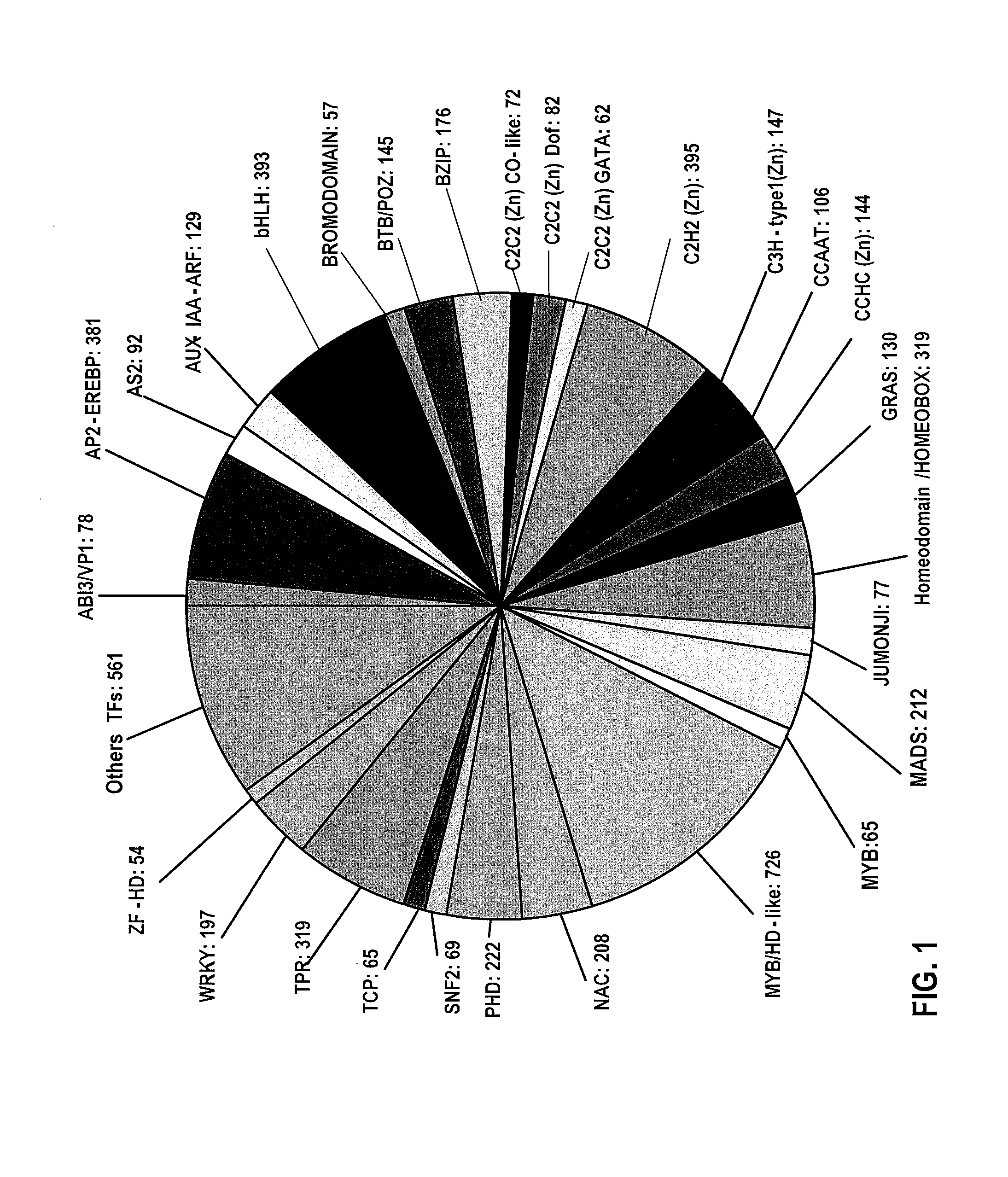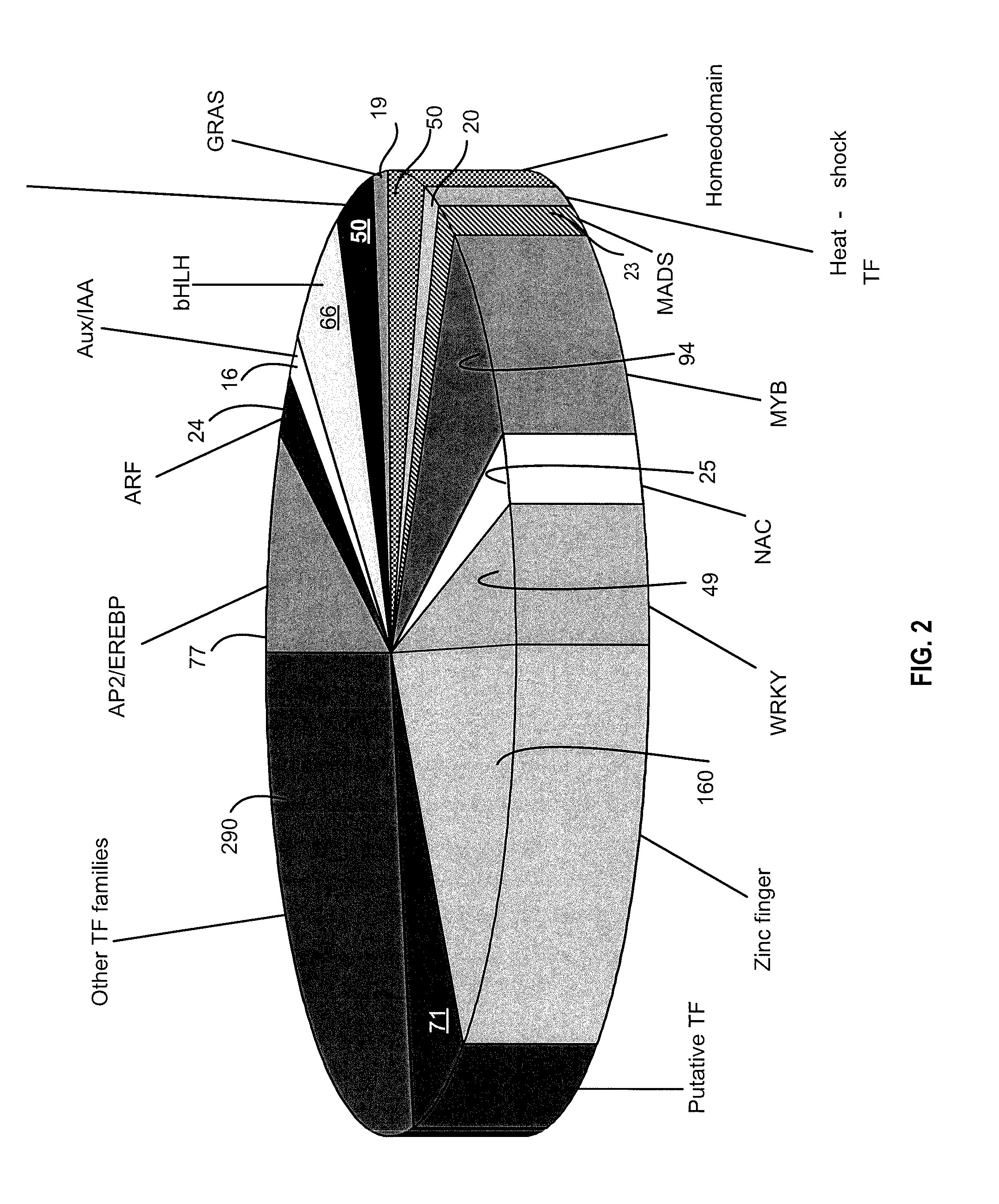Soybean transcription factors and other genes and methods of their use
a technology of transcription factors and soybeans, applied in the field of soybean genes encoding transcription factors, can solve the problems of not being a viable option, tfs are often missed in dna microarray analysis, and the dna microarray technology fails to accurately measure the expression levels of genes expressed at very low levels, so as to increase the resistance of plants and increase the resistance to adverse conditions
- Summary
- Abstract
- Description
- Claims
- Application Information
AI Technical Summary
Benefits of technology
Problems solved by technology
Method used
Image
Examples
example 1
Classification of Regulatory Genes in the Soybean Genome
[0200]The soybean genome has been sequenced by the Department of Energy-Joint Genome Institute (DOE-JGI) and is publicly available. Mining of this sequence identified 5671 soybean genes as putative regulatory genes, including transcription factors. These genes were comprehensively annotated based on their domain structures. (FIG. 1).
[0201]To provide easy access to all soybean TF genes, SoyDB—a central knowledge database has been developed for all the transcription factors in the soybean genome. The database contains protein sequences, predicted tertiary structures, DNA binding sites, domains, homologous templates in the Protein Data Bank (Berman 2000) (PDB), protein family classifications, multiple sequence alignments, consensus DNA binding motifs, web logo of each family, and web links to general protein databases including SwissProt (Boeckmann et al. 2003), Gene Ontology (Ashburner et al 2000), KEGG (Kanehisa et al. 2008), EM...
example 2
A Primer Library for PCR Amplification of Genes Encoding Soybean Transcription Factors
[0210]In order to quantitate the expression of TF genes in soybean, a library containing 1149 sets (or pairs) of PCR primer was designed and synthesized. The sequences of these primers and the Identifier of the corresponding gene are listed in Table 1. These primers allowed for sensitive measurement of the expression levels of 1034 different soybean transcription factors (20% of total TF soybean genes). The number and classification of these TF genes are shown in FIG. 2.
TABLE 1List of primers and sequences in the primer libraryForward primerReverse primerID numberSoybean gene IDCTGCTGCTGATGATGTTCGT (SEQ ID = 1)ACCACGAACTGCGAGATACC (SEQ ID = 2)S4898534Glyma17g34990TTTGCAACTGGAGAACGATG (SEQ ID = 3)ATGAGTATTGGGCCTGACGA (SEQ ID = 4)S4915781Glyma14g29160TCACACACTCACATTCCGGT (SEQ ID = 5)GGTCCTTAAGTCATCAGCGG (SEQ ID = 6)S4901877Glyma19g37780CAGCAGTCAGCAGCAGAATC (SEQ ID = 7)GGAATTCCACAAGGGATTGA (SEQ ID = 8...
example 3
Tissue Specific Transcription Factors in Soybean
[0211]The primers in the primer library described in Example 2 were used to quantitate TF gene expression in 10 tissues from soybean plants. Briefly, soybean strain Williams 82 was grown under normal conditions. RNA samples from 10 different tissues were prepared as described in Example 7 and in U.S. patent application Ser. No. 12 / 138,392. cDNA were prepared from these RNA samples by reverse transcription. The cDNA samples thus obtained were then used as templates for PCR using primer pairs specific for soybean TFs. The PCR products of each TF gene in different tissues were quantitated and the results are summarized in Table 2. FIG. 3 summarizes a total of 38 TFs found to be expressed at much higher levels in one soybean tissue than its expression levels in 9 other tissues tested. The detailed expression levels of all these TFs are shown in Table 2. FIG. 4 shows the expression pattern of a number of representative TFs. These tissue spe...
PUM
| Property | Measurement | Unit |
|---|---|---|
| acidity | aaaaa | aaaaa |
| temperature | aaaaa | aaaaa |
| abiotic stress | aaaaa | aaaaa |
Abstract
Description
Claims
Application Information
 Login to View More
Login to View More - R&D
- Intellectual Property
- Life Sciences
- Materials
- Tech Scout
- Unparalleled Data Quality
- Higher Quality Content
- 60% Fewer Hallucinations
Browse by: Latest US Patents, China's latest patents, Technical Efficacy Thesaurus, Application Domain, Technology Topic, Popular Technical Reports.
© 2025 PatSnap. All rights reserved.Legal|Privacy policy|Modern Slavery Act Transparency Statement|Sitemap|About US| Contact US: help@patsnap.com



